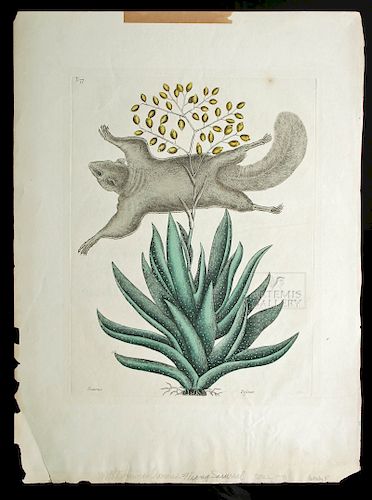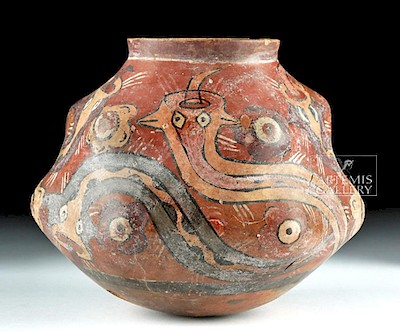18th C. Mark Catesby Colored Engraving, Flying Squirrel
Lot 205
About Seller
Artemis Gallery
686 S Taylor Ave, Ste 106
Louisville, CO 80027
United States
Selling antiquities, ancient and ethnographic art online since 1993, Artemis Gallery specializes in Classical Antiquities (Egyptian, Greek, Roman, Near Eastern), Asian, Pre-Columbian, African / Tribal / Oceanographic art. Our extensive inventory includes pottery, stone, metal, wood, glass and textil...Read more
Categories
Estimate:
$600 - $800
Absentee vs Live bid
Two ways to bid:
- Leave a max absentee bid and the platform will bid on your behalf up to your maximum bid during the live auction.
- Bid live during the auction and your bids will be submitted real-time to the auctioneer.
Bid Increments
| Price | Bid Increment |
|---|---|
| $0 | $25 |
| $300 | $50 |
| $1,000 | $100 |
| $2,000 | $250 |
| $5,000 | $500 |
| $10,000 | $1,000 |
| $20,000 | $2,500 |
| $50,000 | $5,000 |
| $100,000 | $10,000 |
| $200,000 | $20,000 |
About Auction
By Artemis Gallery
Jul 5, 2018
Set Reminder
2018-07-05 10:00:00
2018-07-05 10:00:00
America/New_York
Bidsquare
Bidsquare : Ancient | Ethnographic | Fine Art
https://www.bidsquare.com/auctions/artemis-gallery/ancient-ethnographic-fine-art-3306
Featuring classical antiquities, ancient and ethnographic art from cultures encompassing the globe. Artemis Gallery info@artemisgallery.com
Featuring classical antiquities, ancient and ethnographic art from cultures encompassing the globe. Artemis Gallery info@artemisgallery.com
- Lot Description
Mark Catesby (British, 1683-1749), "Flying Squirrel", a hand colored copper plate engraving on fine laid paper, Plate 77, Volume II. London: printed for Benjamin White, 1771 (Third Edition). A remarkable image from Catesby's "The Natural History of Carolina, Florida, and the Bahama Islands" - one of the most famous color-plate books illustrating American plant and animal life forms, an original work for the study of various American species. An important work on paper from the most impressive illustrated study of natural history created during the colonial period of America. Indeed many regard Catesby's work as the most significant work of American natural history prior to Audubon's "Birds of America"! Size: plate measures 13.625" L x 10.125" W (34.6 cm x 25.7 cm); sheet measures 20.125" L x 14.5" W (51.1 cm x 36.8 cm)
The southern flying squirrel is generally found in forests of deciduous trees in eastern North America; on occasion one can find this species in Mexico and parts of South America. These endearing creatures are petite, agile animals that possess a unique membrane called a patagium connecting the front and hind legs. This enables them to glide very long distances.
Catesby trained as a botanist, and in 1712 traveled to Virginia where he resided for seven years, all the while sending collections of seeds and plants to London. Encouraged by Sir Hans Sloane and other experts, Catesby returned to America in 1722 where he travelled extensively throughout the Carolinas, Georgia, Florida, and the Bahamas, gathering specimens for his "Natural History". In the preface of his book, Catesby describes his process, including his important decision to study with Joseph Groupy so that he could learn how to engrave his plates in order to guarantee accuracy.
Cf. Anker 95; cf. Clark I:55; cf. Dunthorne 72; cf. Fine Bird Books (1990), p. 86; cf. Great Flowers Books (1990), p. 85; cf. Meisel III:340; cf. Nissen BBI 336, IVB 177; cf. Sabin 11509; cf. Stafleu & Cowan TL2 1057; cf. Wood p. 282; cf. Amy Meyers and Margaret Pritchard, Empire's Nature, Mark Catesby's New World Vision, Williamsburg, 1998.
Provenance: private Lucille Lucas collection, Crested Butte, Colorado, USA
All items legal to buy/sell under U.S. Statute covering cultural patrimony Code 2600, CHAPTER 14, and are guaranteed to be as described or your money back.
A Certificate of Authenticity will accompany all winning bids.
We ship worldwide and handle all shipping in-house for your convenience.
#134238Excellent condition. Strong plate mark. Normal toning to paper. Small stain at upper right. Tape at edge of upper border. Small losses to edges of sheet and creases to margins with a faint one at the middle. Still, very good as an 18th century colonial work.Condition
- Shipping Info
-
All shipping is handled in-house for your convenience. Your invoice from Artemis Gallery will include shipping calculation instructions. If in doubt, please inquire BEFORE bidding for estimated shipping costs for individual items.
-
- Buyer's Premium



 EUR
EUR CAD
CAD AUD
AUD GBP
GBP MXN
MXN HKD
HKD CNY
CNY MYR
MYR SEK
SEK SGD
SGD CHF
CHF THB
THB














